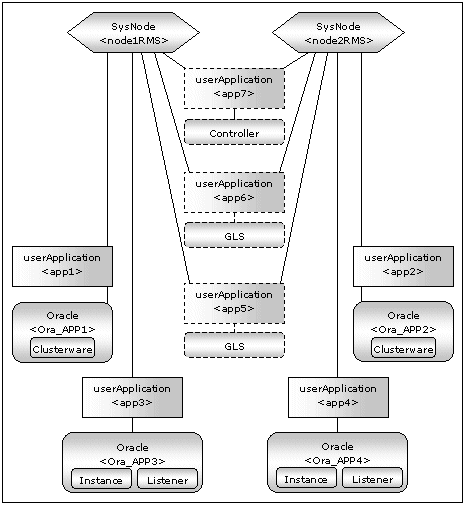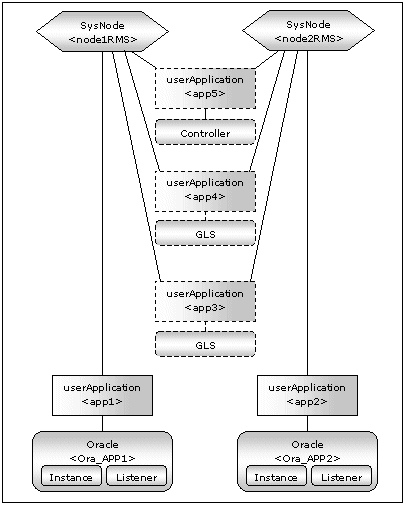In Oracle RAC 10g or later, Oracle instances and listeners are managed as PRIMECLUSTER RMS resources. Also, the Oracle Clusterware can be registered in an RMS resource optionally.
Configuration A
The Oracle Clusterware and Oracle RAC instance are registered in different userApplication.

userApplication | Description | Resources |
app1, app2 | Controls Oracle Clusterware. | Oracle resource (Clusterware) |
app3, app4 | Controls Oracle instances and listeners. | Oracle resource (instances, listeners) |
app5, app6 | Used as standby for Gls or takeover network. (Option) | Gls resource, etc |
app7 | Starts up or stops Oracle instance userApplication (app3 and app4) simultaneously on all nodes. | Controller resource |
If userApplication app3 and app4 are stopped due to an Oracle RAC instance resource failure, userApplication app1 and app2 of Oracle Clusterware will not be affected.
Information
Use the configuration A if Oracle Clusterware is registered in an RMS resource, and each node has multiple Oracle RAC instances.
The controlling userApplication (app7) is optional and can be used to start up or stop userApplication (app3 and app4) for Oracle instances on all nodes at the same time
The following setup values are recommended for userApplication which controls Oracle Clusterware (app1, app2). The other attributes that are not described below are optional.
Attributes | Values |
Operation method | Standby |
AutoSwitchOver | No |
PersistentFault | 1 |
The following setup values are recommended for userApplication which controls Oracle instances and listeners(app3, app4). The other attributes that are not described below are optional.
Attributes | Values |
Operation method | Standby |
AutoStartUp | Optional |
AutoSwitchOver | No |
PersistentFault | 1 |
Note
If the “KeepOnline” flag of Oracle Clusterware resource is enabled, the userApplication which controls Oracle instances should be stopped first, and then the userApplication which controls Oracle Clusterware should be stopped.
(In the above image, app3 should be stopped before app1 stopping. app4 should be stopped before app2 stopping.)
For further details of the “KeepOnline” flag, refer to “2.3.4 userApplication with Oracle Clusterware”.
Configuration B
The Oracle Clusterware and Oracle RAC instance are registered in the same userApplication.

userApplication | Description | Resources |
app1, app2 | Controls Oracle Clusterware. | Oracle resource (Clusterware, instances, listeners) |
app3, app4 | Used as standby for Gls or takeover network. (Option) | Gls resource, etc |
app5 | Starts up or stops Oracle instance userApplication (app1 and app2) simultaneously on all nodes. | Controller resource |
If userApplication app1 and app2 are stopped due to an Oracle RAC instance resource failure, Oracle Clusterware will also be stopped (when the KeepOnline flag is disabled).
Information
Use the configuration B if Oracle Clusterware is registered in an RMS resource, and an Oracle RAC instance exists on one node only. If you are planning to add Oracle RAC instances in the future, use the configuration A.
The controlling userApplication (app5) is optional and can be used to start up or stop userApplication (app1 and app2) for Oracle instances on all nodes at the same time.
The following setup values are recommended for userApplication which controls Oracle Clusterware, Oracle instance and listener (app1, app2). The other attributes that are not described below are optional.
Attributes | Values |
Operation method | Standby |
AutoStartUp | Optional |
AutoSwitchOver | No |
PersistentFault | 1 |
Configuration C
The Oracle Clusterware is not registered.

userApplication | Description | Resources |
app1, app2 | Controls Oracle instances ad listeners. | Oracle resources (instances, listeners) |
app3, app4 | Used as standby for Gls or takeover network. (Option) | Gls resource, etc |
app5 | Starts up or stops Oracle instance userApplication (app1 and app2) simultaneously on all nodes. | Controller resource |
Information
Select the configuration C if you want to make Oracle Clusterware automatically start up along with OS startup without registering it in an RMS resource.
The controlling userApplication (app5) is optional and can be used to start up or stop userApplication (app1 and app2) for Oracle instances on all nodes at the same time
The following setup values are recommended for userApplication which controls Oracle instances and listeners (app1, app2). The other attributes that are not described below are optional.
Attributes | Values |
Operation method | Standby |
AutoStartUp | Optional |
AutoSwitchOver | No |
PersistentFault | 1 |
The flow of userApplication creation is as follows:
1 | Register Oracle Clusterware resources | |
2 | Register Oracle instance and listener resources | 2.3.5 userApplication with Oracle RAC Instances and Listeners |
3 | Register the other required resources | |
4 | Create userApplication | 2.3.7 Configuration-Generate and Configuration-Activate |
userApplication is configured with the RMS Configuration Wizard. This RMS Configuration Wizard forms Wizard format as follows:
Menu -> Settings -> Next button
Information
For setting the userApplication Configuration Wizard, see “Chapter 6 Cluster application configuration” of the “PRIMECLUSTER Installation/Administration Guide”.
PersistentFault remains the same resource status (Faulted) even after RMS is restarted in the event of a resource failure. Users are supposed to locate the fault and check completion of recovery processing then start userApplication manually. For example, if a failure occurs, users can detect which userApplication failed even after server reboot. Even though AutoStartUp setup is set, userApplication will not be started, and automatic startup will prevent recurrence of the failure.
Be sure to set AutoStartUp=yes when the Oracle instance is activated from Oracle Clusterware right after OS startup, data inconsistency might occur. If the controlling userApplication is not used, select AutoStartUp=yes.
Note
Do not create multiple resources for the same Oracle instance, Listener or Oracle Clusterware.